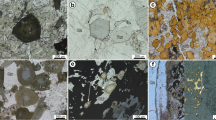Abstract
Conflict minerals is a term applied to ores mined in conditions of armed conflict and human rights abuse. Niobium and tantalum are two rare metals whose primary natural occurrence is in the complex oxide minerals columbite and tantalite, the ore of which is commonly referred to as coltan. The illicit export of coltan ore from the Democratic Republic of the Congo is thought to be responsible for financing the ongoing civil conflicts in this region. Determining the chemical composition of an ore is one of the means of ascertaining its provenance. Laser-induced breakdown spectroscopy (LIBS) offers a means of rapidly distinguishing different geographic sources for a mineral because the LIBS plasma emission spectrum provides the complete chemical composition (i.e., “chemical fingerprint”) of any material in real time. To test this idea for columbite–tantalite, three sample sets were analyzed. Partial least squares discriminant analysis (PLSDA) allows correct sample-level geographic discrimination at a success rate exceeding 90%.



Similar content being viewed by others
References
Hurlburt CS, Klein C (1977) Manual of mineralogy. Wiley, New York
Papp JF (2010) Niobium (columbium) and tantalum: 2008 US geological survey minerals yearbook 52:1–14. http://minerals.usgs.gov/minerals/pubs/commodity/niobium/myb1-2008-niobi.pdf. Accessed 1 Feb 2011
Todd B (2006) Congo, coltan, conflict. Heinz School Rev 3:1. http://journal.heinz.cmu.edu:8010/articles/congo_coltan_conflict/. Accessed 1 Feb 2011
US public law no: 111–203. Conflict minerals provision of the Dodd–Frank Wall Street Reform and Consumer Protection Act
Melcher F, Sitnikova MA, Graupner T, Martin N, Oberthür T, Henjes-Kunst F, Gäbler E, Gerdes A, Brätz H, Davis DW, Dewaele S (2008) Fingerprinting of conflict minerals: columbite–tantalite (‘coltan’) ores. SGA News 23:6–14
Hess FL, Whitney RJ, Trefethen J, Slavin M (1943) The rare alkalis in New England. US Bureau Mines, Info Circ #7232, 51p
Fisher J (2002) Gem and rare-element pegmatites of southern California. Mineral Rec 33:363–407
Houser CE, Farquharson PT (2003) The Pack Rat mine. In: Murbach ML, Hart MW (eds) Geology of the Elsinore fault zone, San Diego region. San Diego Assoc Geol/South Coast Geol Soc 31:63–67
Jolliffe AW (1943) Tin and Tantalum deposits, Sproule Lake, Ross Lake, area, Northwest Territories. unpub report, Geol Surv Can, 3p
Rowe RB (1952) Pegmatite deposits of the Yellowknife-Beaulieu region, District of Mackenzie. Geol Surv Can Paper 52–58
Jolliffe AW (1944) Rare element minerals in pegmatites, Yellowknife-Beaulieu area, Northwest Territories. Geol Surv Can Paper 44–12
Wise MA (1987) Geochemistry and crystal chemistry of Nb, Ta and Sn minerals from the Yellowknife pegmatite field, N.W.T. PhD thesis, Univ Manitoba, Winnipeg
McMillan NJ, Harmon RS, De Lucia FC, Miziolek AW (2007) Laser-induced breakdown spectroscopy analysis of minerals—carbonates and silicates. Spectrochem Acta B 62:1528–1536
Harmon RS, Remus JJ, McManus C, DeLucia FC Jr, Gottfried J, Miziolek AW (2009) LIBS analysis of geomaterials: geochemical fingerprinting for the rapid analysis and discrimination of minerals. Appl Geochem 24:1125–1141
Gottfried JL, Harmon RS, DeLucia FC Jr, Miziolek AW (2009) Multivariate analysis of LIBS spectra for geomaterial classification. Spectrochim Acta B 64:1009–1019
Bol’shakov AA, Yoo JH, Liu C, Plumer JR, Russo RE (2010) Laser-induced breakdown spectroscopy in industrial and security applications. Appl Optics 49:C133–C142.
Ercit TS (1994) The geochemistry and crystal chemistry of columbite group minerals from granitic pegmatites, southwestern Grenville Province, Canadian Shield. Can Miner 32:421–438
Mira JP, Figueiredo MO (2006) Pattern of minor element enrichment in columbites: a synchrotron radiation X-ray fluorescence (SRXRF) study. Chem Geol 225:402–410
Beurlen H, Da Silva MRR, Thomas R, Soares D, Olivier P (2008) Nb–Ta–(Ti–Sn) oxide mineral chemistry as tracer of rare element granitic pegmatite fractionation in the Borborema Province, northeastern Brazil. Miner Depos 43:207–228
Kim S-Y, Moon H-S, Park NY (1989) Mineral chemistry of cassiterite, columbite, tantalite and associated minerals from Soonkyoung tin-bearing pegmatite. J Korean Inst Mining Geol 22:327–339
Tindle AG, Breaks FW (2000) Columbite–tantalite mineral chemistry from rare-element granitic pegmatites: Separation Lake area, N.W. Ontario, Canada. Contrib Mineral Petrol 70:165–198
Uher P, Žitňan P, Ozdin D (2007) Pegmatitic Nb–Ta oxide minerals in alluvial placers from Limbach, Bratislava Massif, Western Carpathians, Slovakia: compositional variations and evolutionary trend. J Geosci 52:133–141
Acknowledgments
This research was supported by Army Research Laboratory Fellow funding to RSH and financial support to KMS from the II–VI Foundation and was facilitated by technical support from Applied Spectra, Inc.
Author information
Authors and Affiliations
Corresponding author
Additional information
Published in the special issue Laser-Induced Breakdown Spectroscopy with Guest Editors Jagdish P. Singh, Jose Almirall, Mohamad Sabsabi, and Andrzej Miziolek.
Rights and permissions
About this article
Cite this article
Harmon, R.S., Shughrue, K.M., Remus, J.J. et al. Can the provenance of the conflict minerals columbite and tantalite be ascertained by laser-induced breakdown spectroscopy?. Anal Bioanal Chem 400, 3377–3382 (2011). https://doi.org/10.1007/s00216-011-5015-2
Received:
Revised:
Accepted:
Published:
Issue Date:
DOI: https://doi.org/10.1007/s00216-011-5015-2




